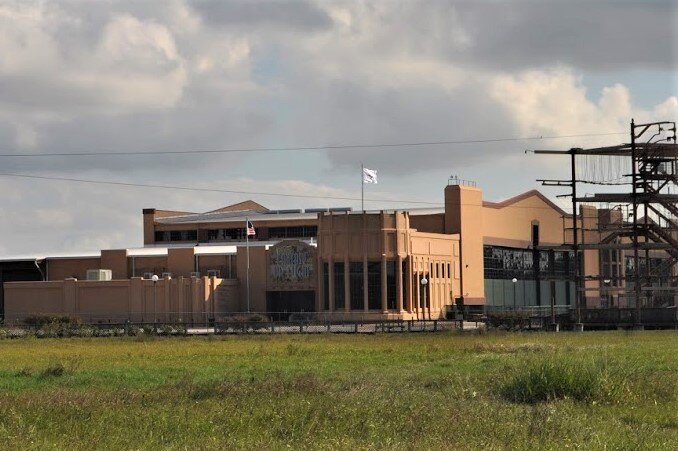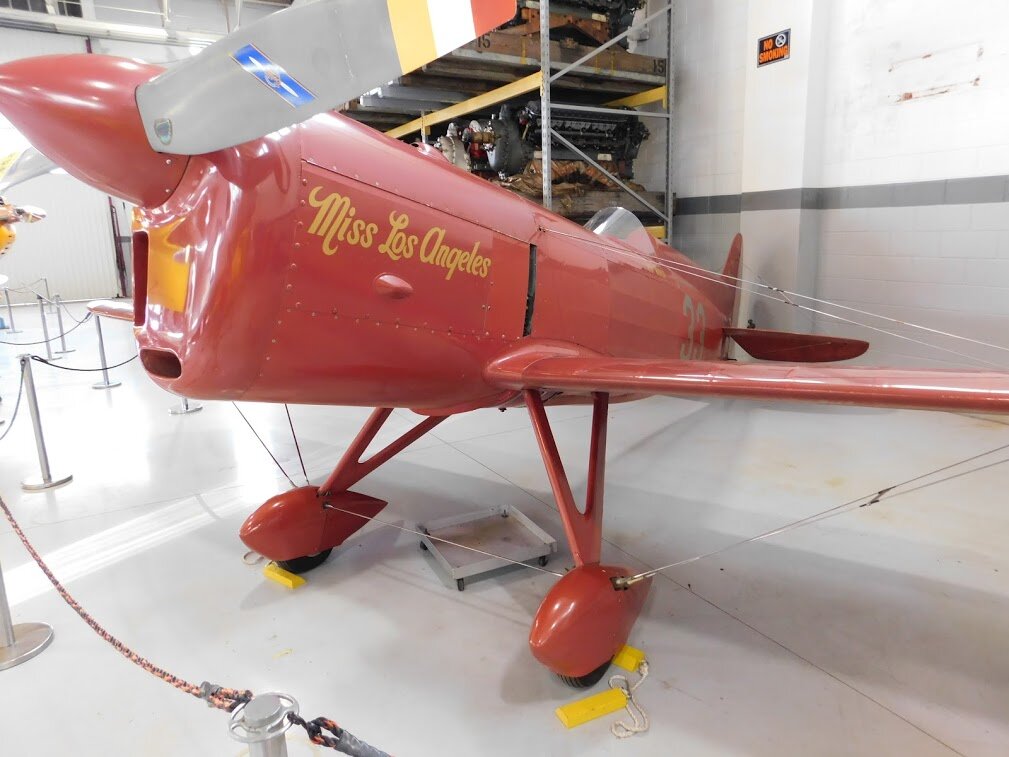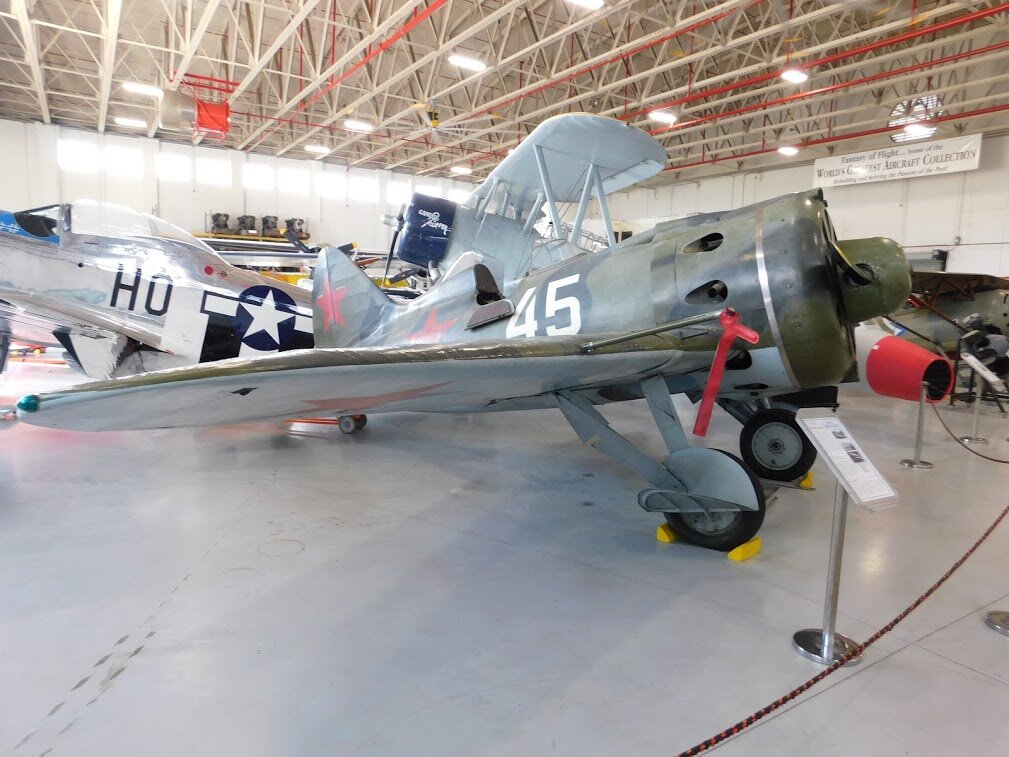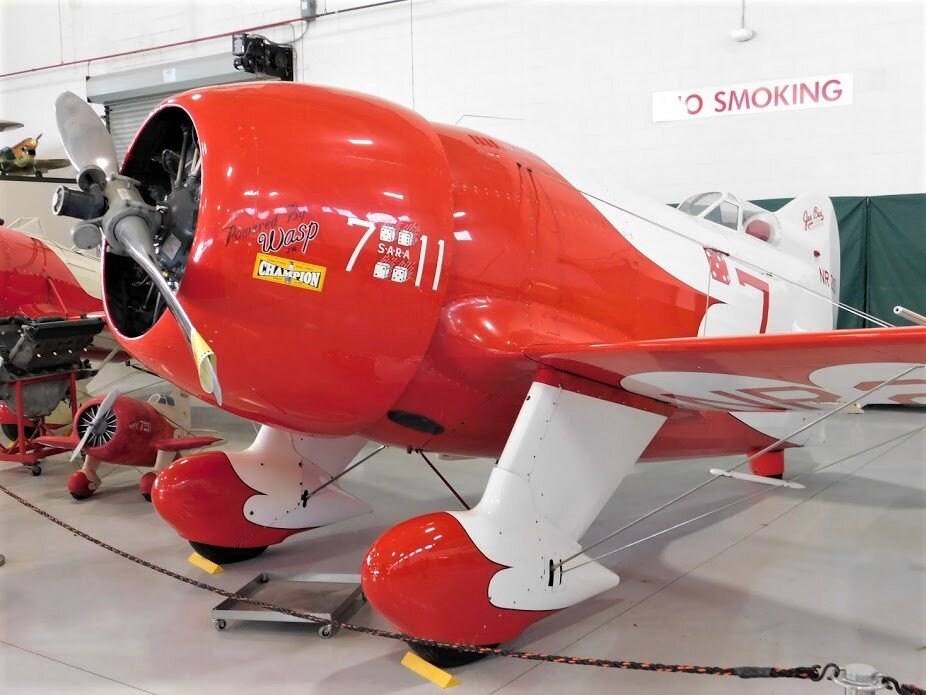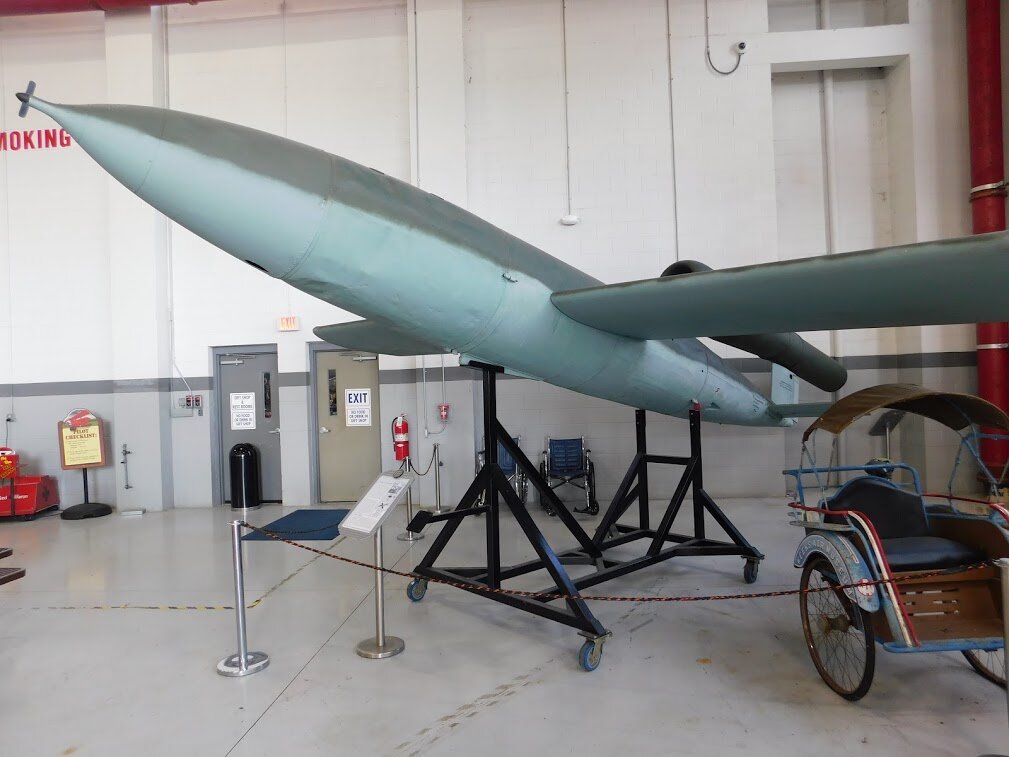Fantasy of Flight, Polk City FL
Issue 23 May, 2021
———————————————————————
In September of 1955 Juan Peron, the colorful President of Argentina, was deposed by a military coup. He was held prisoner for 12 days on a gun ship of the Paraguayan Navy that was anchored in Buenos Aires harbor. He was eventually granted asylum and the President of Paraguay sent a plane to land in the harbor and pick up Peron. That same plane, a Consolidated PBY-5A Catalina, is on display at the Fantasy of Flight Museum in central Florida.
—————————————————————-
Fantasy of Flight is the private collection of Kermit Weeks and is one of the few museums that we have seen that maintains most of its planes in flying condition. Weeks has said that every plane in his collection has either been flown by him, is currently being flown by him, or will be flown by him.
While in high school, Weeks became interested in flight and aircraft design and built his first plane even before he learned to fly. In college, Kermit began flying in aerobatic competitions and, by 1977, he had built the Weeks Special, qualifying in it for the United States Aerobatic Team. Flying in aerobatics competition for over 10 years, he placed in the top three in the world five times and won a total of 20 medals in World Aerobatics Championship competition. He has twice won the United States National Aerobatics Championship. Not surprisingly, the museum contains a number of historic aerobatic aircraft.
The collection was originally located in Miami, named the Weeks Air Museum, but that museum was mostly destroyed by hurricane Andrew. After the hurricane, Kermit purchased property in Polk City, in central Florida, and decided to relocate his museum there. The museum was originally much larger than we visit today, but the main building is currently closed and Act Three of Fantasy of Flight is in the design phase. The building currently open to visitors, referred to as “Museum Light”, is just a small part of the collection, but it contains a wide variety of aircraft, all in amazing condition.
Currently, the larger building that we see here is the home of restoration and storage for the many aircraft in the Weeks collection and can be visited, in small groups, by making a reservation. This private tour has an additional fee and is available on most days of the year. Watch for a visit to this area of the museum in a future blog.
Let’s take a look at what is on display today.
The first vintage aircraft Kermit owned was a North American T-6 Texan that he bought so he could train on the same type of aircraft that WW-II pilots trained on. Not long after he bought the Texan, this P-51 became available, a plane he always dreamed of owning. Pretty quickly he realized that vintage aircraft were going to be his life’s work and he began planning the Weeks Air Museum.
The North American P-51 was originally powered by an Allison V-12. Later models such as this D model, built in 1945, were powered by the Rolls Royce Merlin. The Merlin engine had a two-stage supercharger, unlike the single-stage of the Allison. This made the Merlin-powered Mustang much more efficient above 15,000 feet and capable of high-altitude bomber escort.
(NOTE- Reader Robert Walter sent this additional information about the P-51 engine- “The production Mustang was powered not by a Rolls Royce Merlin, but by a Packard Merlin (extensively redesigned for mass production and with some significant hardware changes (Carb, supercharger, indium plated bearing surfaces) and upgrades (though most of these were folded back into the R-R produced units). The Packard Merlin was built in Detroit, and besides the Mustang, it found its way into some P-40s and Lancasters.” Thanks Bob! I always try to add as much detail to the blog as possible, but there are obviously limits to how deep to go, especially on the subject of engines. This point about who built the P-51 Merlins (under license from Roll-Royce), is an important detail. Tony)
The museum’s P-51 is painted to honor the Mustang of Major George Preddy, the highest scoring Mustang ace. From North Carolina, George Preddy and his younger brother William, also a P-51 pilot, are honored at the North Carolina Aviation Museum (Click here to read more about George Preddy in Issue 16 )
Built in 1931, during the height of the depression, the Gee Bee Z was an attempt by the Granville Brothers of Springfield Mass to overcome the dwindling sales of their small sport plane business. Built specifically to compete in the Cleveland Air Races, the brothers hoped to claim some of the prize money that was being awarded at air races throughout the country. Flown by expert racer Lowell Bayles, the Gee Bee Z won every race it entered, including the prestigious Thompson Trophy pylon race. Unfortunately, Bayles lost his life, and the plane was destroyed, when a wing came off during a high-speed test.
One of the interesting features of this museum is that the plaques at each aircraft giving details about the plane have additional Kermit’s Comments- adding more specific information about the plane. Talking about this beautiful Gee Bee Z replica, Kermit says that, after flying it a few times, he wanted to further investigate the reason for the crash of the original. He hired Leon Tolve to do some flutter testing and it was determined that there was a definite aileron flutter problem above 240 mph. Bayles was estimated to have been flying at over 300 mph when he crashed. Plans have been drawn up to add aileron balance weights so that this replica can be safely flown above 240 mph.
The Curtis Robin was an early cabin-class monoplane designed to be practical and affordable, using WW-I surplus OX-5 engines. Introduced in 1928, the three-person plane (pilot up front, two passengers in the rear) was immediately popular and the enclosed cabin made it practical for both personal and commercial use. One early use of a Robin was for delivering the Nebraska Daily Gazette. Each day the Robin would fly over Nebraska, dropping bundles of newspapers over each town. That particular Robin is in The Museum of Flight in Seattle (see Issue 12 https://aviationhistorymuseums.com/blog/2020/5/23/the-museum-of-flight ).
Despite its simple construction and modest engine, the Robin was used for a number of record setting flights. In 1929, Red Jackson completed over 400 consecutive slow rolls in a Robin. Later that year Jackson, along with Forest O’Byrne, flew non-stop above St Louis for 27 days, setting the record for the longest time airborne. That record was broken in 1935 by brothers Al and Fred Key in another Robin, who were airborne for almost a month. That Robin was air-refueled and supplied by yet another Robin.
Perhaps the best-know flight in a Robin took place in 1938. Douglass Corrigan had applied for permission to fly from New York to Europe, but his old and poorly maintained Robin was deemed unsafe, and his request was turned down. Corrigan instead filed for a flight to California but, later claiming that he had a malfunctioning compass, he landed in Ireland 28 hours later, earning himself the legendary nickname Wrong-Way Corrigan.
The Curtiss Robin in The Fantasy of Flight Museum was donated by World Aerobatic Champion Henry Haigh and is one of only a handful of flying examples.
Introduced in 1936, the Grumman J2F Duck was the first of a long line of amphibious aircraft built by Grumman. Powered by a Wright Cyclone R-1820, this is one of only a few remaining airworthy Ducks. Like other Grumman models produced during WW-II (including the F4F and TBM), manufacturing of Ducks was transferred to another manufacturer when the Grumman factory became overwhelmed with orders. In the case of the Duck, the new manufacturer was Columbia Aircraft Corporation of Long Island, who manufactured this particular plane. Unlike standard Navy practice of designating aircraft according to the manufacturer (the Grumman TBF, for instance, was designated the TBM when manufactured by General Motors), the Duck retained the J2F designation at Columbia Aircraft.
The Duck in the Weeks museum is painted in the colors of The Candy Clipper. Assigned to the Philippines in 1941, that Duck was abandoned after being bombed by the Japanese. Using parts from other planes, The Candy Clipper was made flyable by mechanics from a P-40 squadron and used to fly in supplies during the siege of the Philippines. Like the Candy Bomber during the Berlin Airlift, candies for the kids were included in the supplies. The Duck had a crew of two with a small area for two more below, utilized during sea rescues. During the Battle of Bataan, The Candy Clipper was the last aircraft to depart, overloaded with the pilot and five passengers.
Kermit’s Comments mentions that several years ago he flew this plane to Cypress Gardens for a water ski show. After a casual remark, he wound up towing two water skiers for several laps with his Duck.
The Fantasy of Flight Museum is very much a working hangar and, as such, there are not as many exhibits as in other museums, which have only static aircraft on display. There are, however, some very interesting exhibits like this rare Allison 3420. The 2,600+ HP, 24-cylinder engine is essentially, two Allison 1710s, although there are only a few common parts. Only four aircraft types ever flew with this engine, and none went into full-scale production. In November 1943, the Fisher XP-75 was the first to fly with the V-3420. The Allison engine performed fairly well, but the P-75 did not, and it was eventually scrapped. The only other new aircraft to utilize the 3420 was the Lockheed P-58 Chain Lightning, a long-range aircraft developed from the P-38. This prototype proved unsuccessful and was also scrapped. Two other aircraft using this engine, the XB-19 and the XB-39 (a version of the B-29) were also short-lived. Only 167 of these engines were ever built (plus two marine versions) making this quite a rare engine.
When you visit, there is likely to be a vintage plane or two on the ramp out front, plus there are two planes on permanent display outside. Besides the PBY mentioned earlier there is a Lockheed Constellation.
This L-1649 Constellation, S/N 1040, was originally delivered to Lufthansa in December 1957. Converted to a freighter in 1960, it continued in service with Lufthansa until 1966. She was owned by, or leased to, a number of operators until being put in storage several times in Alaska and in Texas from 1972 to 1976. After that, the Connie went through several private owners until being sold to Maine Coast Airways in 1986. After being restored in Fort Lauderdale, a ferry flight to Maine was attempted in 1988, but it resulted in an emergency landing in West Palm Beach. A second attempted ferry flight ended in an emergency landing in Sanford Florida, where the Connie sat for 12 years until it was again restored. A successful ferry to Fantasy of Flight was made in 2001. After several more change of hands, the Connie became the property of Fantasy of Flight. Kermit posted an interesting YouTube video about the history of Constellations and the ferry flight to Polk City:
As mentioned in the introduction, the Weeks collection contains a number of historic air racers. Very few of the racers from the Golden Age of Air Racing (c1929-1939) still survive, as racers either crashed or were used as the base for building new and faster models. Most of the racers in the collection are replicas, but they are built to exacting standards. One racer that is original is this 1933 Brown B-1 Racer.
Designed in California by Lawrence W. Brown, the B-1 was built for Ralph Bushey to fly in the Cleveland Air Races and other races being held in the 1930s. Bushey won races in New Orleans and Miami, but the plane was then badly damaged in a landing accident. Put into storage until it could be re-built, The B-1 remained untouched until after WW-II. It was re-built in 1947 and competed for a couple of years, then returned to storage. The B-1 passed through a number of owners, winding up at the Weeks Museum where it was restored to its original, and flying, condition.
In this Lawrence Brown B-2 replica, you can see his trademark design. The front profile is as small as possible and the plane is as streamlined as possible. The original Miss Los Angeles premiered at the 1934 National Air Races. Flown by Roy Minor, she took first place in the Greve Trophy competition. This outstanding replica was built in 1971.
This Italian 1929 Savoia Marchetti S-56 was one of six built under license in the US by the American Aeronautical Corporation. Powered by a Kinner K5 radial, it was used as a spotter plane during prohibition by the New York Police Department. The S-56 was restored to very high cosmetic condition at the Cradle of Aviation Museum on Long Island, but not to flying standards. Kermit’s Comments say that he hopes to fly it some day and he takes us through his current project which is to get it registered with its original registration, NC349N. Due to a break in registration in the 1950s, it is a challenging process.
PHOTO Courtesy of Fantasy of Flight
Recently put on display is this Boeing B-29 nose section. This exhibit was one of the many that was heavily damaged in Miami by Hurricane Andrew and have since been restored. This aircraft, 45-21787, was delivered to the Army Air Corps in 1945. It was transferred to the Navy in 1947 for long-range search operations and designated P2B-1S, BuNo 84029. It was later assigned to NACA (the forerunner of NASA) and was used as the mothership (hence Fertile Myrtle) to drop the Douglas D-558 Skyrocket. With Scott Crossfield at the controls, the Skyrocket was the first plane to exceed Mach 2. Although the parts are in various locations, the entire airframe of Fertile Myrtle still exists.
First flown in 1933, the Polikarpov I-16 had a number of advanced design features for its time such as cantilevered wings and retractable landing gear. I-16s were flown by Republican forces during the Spanish Civil War and by Soviet Forces for the first several years of WW-II. This plane was found as a wreck at the original Polikarpov factory and is slated for a complete re-build to flying condition. Kermit’s Comments- “Is this the cutest little plane or what? It has the coolest sounding engine and I can’t wait to fly it!”
There are a number of aircraft in the collection representing the WW-I era including a British Sopwith Pup.
The small and docile Pup entered service in 1916 with the Royal Navy Air Service (RNAS). Its flying characteristics made it an ideal plane for early carrier operations. The RFC also began flying the Pup in 1916. It proved successful, but by 1917, it was being overpowered by newer German fighters. The Pups were eventually replaced by the more powerful Sopwith Camel.
As mentioned in other issues, there are not many original WW-I aircraft that have survived. With original WW-I planes being over 100 years old, and construction mainly of wood and fabric, it is not surprising that few have survived.
This E-1, designed and manufactured by the Standard Aircraft Company of Elizabeth NJ, is an original. Production of the E-1 trainer, powered by a Gnome 100 hp rotary engine, began in 1918. The Gnome engine proved difficult for students and it was replaced by the 80 hp Le Rhône rotary. A total of 168 of both versions were built before the order was cancelled in November 1918, at the end of the war. The museum’s E-1 is Le Rhône powered and Kermit’s Comments mention that the Le Rhône engine is one of the few rotary engines that have any degree of “throttle-ability”. As I said, Kermit’s additions to the write-ups, with first hand experience, add a unique flavor to this museum experience.
Also powered by a Le Rhône rotary engine, the French built Nieuport 17 was flown by French, British, Italian, Belgian, and American pilots. The design was also copied by Germany from a captured Nieuport 17. The only original surviving example of the Nieuport (a 23 model) is in the Royal Museum of the Armed Forces and Military History in Brussels.
Painted in the classic red and white paint scheme is this 1932 Gee Bee Super Sportster R-2. The R-1 and R-2 were very similar, but the R-2 had a slightly smaller engine (P&W R-985 vs P&W R-1340 of the R-1). The R-2 was built for cross country racing with a little more fuel and a little lower fuel consumption. The two aircraft were the most successful racers of their time. Jimmy Doolittle raced the R-1 and won the 1932 Thompson Trophy. Doolittle also set a new landplane speed record of 297 MPH (seaplanes of the time were generally faster than landplanes). The R-1 and R-2 continued the reputation of the Gee Bees of being fast and dangerous with Russell Boardman being killed in an R-1 during the 1933 Bendix Trophy race. Although there are several other R-1 and R-2 replicas, this is the only flying model. Like the Gee Bee Z, Kermit plans flutter research on this plane before flying it.
Finally, let’s mention the Consolidated B-24J Liberator that dominates the center of the museum. This plane was one of a group of B-24s that were sent to the RAF as part of the Lend-Lease program. It was most likely assigned to 215 RAF Squadron in Kolar, India. In this role it would have participated in long-range bombing missions over Burma.
The B-24 served in all theaters during WW-II and took on many roles other than bomber such as: mine laying, photo reconnaissance, cargo, and general transport. Although it was meant as a replacement for the B-17, both four-engine bombers served through the end of the war and there was always a great rivalry between crews of the two types.
-------------------------------------------------------------------
When completed, Act 3 of Fantasy of Flight will likely be a much larger museum than we see today. That doesn’t mean it isn’t worth a visit now. In fact, I would place today’s Fantasy of Flight very high on a list of museums worth visiting.
Note- the aircraft on display will change from time to time, as will the other exhibits, an excellent reason to visit more than once!
A special thanks to Sara Smith of Fantasy of Flight for her assistance in research for this blog.
——————————————————————————————————————————-
—————————————————————————————————————————-
To learn about what to do in the local area, museum hours and costs, as well as books to read and other interesting odds and ends, keep reading! At the end you will find a photo gallery of the entire museum.
PLANNING YOUR VISIT
The Museum keeps irregular hours throughout the year so check the website for opening information.
https://www.fantasyofflight.com/collection/contact-info/2015-calendar/
Adults: $12.00 plus Sales Tax
Seniors (55+) $10.00 plus Sales Tax
Children (6-12) $8.00 plus Sales Tax
FLYING IN
The field that is home to Fantasy of Flight is not open to the public. Located 11 miles from Fantasy of Flight is Winter Haven Regional Airport (KGIF). Winter Haven has a 5,000’ runway (5/23) and a 4,000’ runway (11/29). There are RNAV approaches to 05 and 11 and a VOR circling approach. There is a full-service (including rental cars) FBO.
LOCAL ATTRACTIONS
Lakeland Airport, home of The Florida Air Museum (Issue 19) is just 23 miles away, which makes it pretty easy to visit both museums in one day.
The Museum of Flight is located just 21 miles from Disney World and 45 miles from Tampa, and there are endless possibilities for other activities in the area.
WHERE TO EAT
Polk City BBQ was mentioned by museum staff, just 1.5 miles away.
SUGGESTED READING
While doing research for this blog, I came across The Golden Age of Air Racing, pre-1940 by S.H. Schmid and Truman C. Weaver. Published by the Experimental Aircraft Association (EAA), this intriguing book is a compilation of magazine articles, full of photos, facts and technical details. No longer in print, I found one reasonably priced on eBay (and there were many not reasonably priced!). If you are interested in the subject, this is an excellent reference book.
MUSEUM WEBSITE
https://www.fantasyofflight.com/collection/
UP NEXT
Air Victory Museum, Lumberton NJ
MUSEUMS ARE WHERE YOU FIND THEM
This segment is dedicated to finding interesting aviation artifacts that are in public view- but not in an aviation museum. If you see one send a photo!
PHOTO Courtesy of Mike Bruno
A number of airports have an aircraft on display or a small museum area. My brother Mike recently took these photos of the rather extensive museum in the passenger terminal at McCarren Field, in Las Vegas. Parts of the museum are scattered throughout all of the airport terminals.
PHOTO Courtesy of Mike Bruno
This 1956 Thunderbird was used as the ramp vehicle at George Crockett’s Alamo Aviation from 1957 until 1968.
PHOTO Courtesy of Mike Bruno
Hanging above the Terminal 1 baggage claim, this 1958 Cessna 172 set an endurance record in 1959. Robert Timm and John Cook stayed aloft for 64 days, 22 hours, 19 minutes and 5 seconds to set the World Endurance Aloft flying record, a record which still stands today. The T-Bird shown above was the chase vehicle for the record setting flight.
PHOTO GALLERY
click to enlarge
Issue 23, Copyright©2021, all rights reserved. Except where noted, all photos by the author


